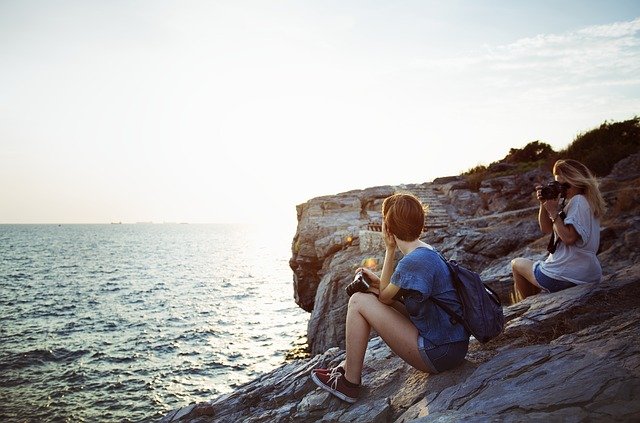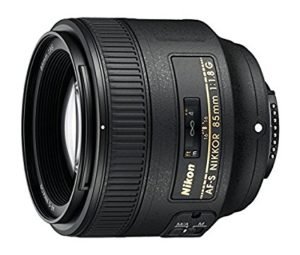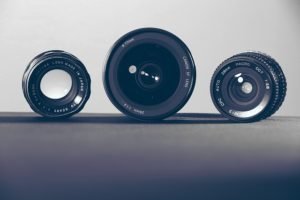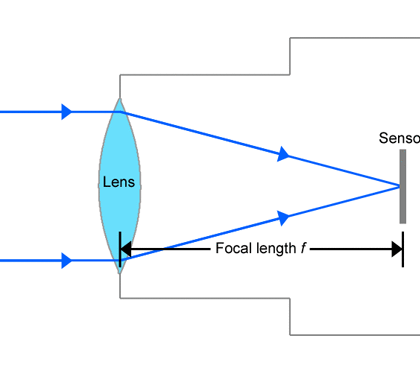
Welcome to our Guide on the First DSLR Lenses to Buy for Beginner Photographers

Today, we will go over how to choose the First DSLR lens to Buy beyond the initial kit Lens that comes with most DSLR camera packages. And the reason we are going to help you with that is, it’s a really hard decision. If you want to make great photos or shoot great videos, you need some quality glass to help you with that. And, it’s a tough decision to make with all of the information out there. So, in this article, we are going to make that decision a lot easier for you.
One of the things I will say is that sometimes you do need to try these lenses before you buy them. That’s why I always recommend that instead of just picking Canon or Nikon or Sony because a pro tells you. I think that you should pick a camera system that a lot of your friends and family members are shooting on. That way you can borrow lenses and borrow other gear and accessories from them and so you can try it out, learn how to use it, and learn what fits you as a creator. I think that’s so important and I think that that’s a good way to decide what camera system you want to buy.  So if you have a friend or family member that is a bit ahead of you in accumulating their camera gear, start there and think of it as an extended try before you buy campaign, that is the easiest way to make sure you won’t regret whatever camera lens you choose to buy.
So if you have a friend or family member that is a bit ahead of you in accumulating their camera gear, start there and think of it as an extended try before you buy campaign, that is the easiest way to make sure you won’t regret whatever camera lens you choose to buy.
But, if that’s not an option for you though, you can rent lenses before you buy them and it’s not that expensive, honestly. You can rent Lenses over at Lumoid. Let’s say you were thinking of getting an 85mm f1.8 portrait lens It could cost you around $400, but you don’t know if you are sold on it or not and that’s why you decide to rent it. So, you get to play with it for a couple of days and make an informed buying decision. If you want to do that, you can use this link to, so that you can try stuff out before you buy it, if you don’t have the luxury of going to a friend or a family member.
Big Tip #1: Try Before You Buy, and make a better choice on the first DSLR Lens to Buy
Ask to borrow the lens from a friend or family member and take them out for a drink as a thank you. It’s a win-win
Rent the lens and use it for a couple of days, then you will get a feel for the equipment and feel that much better about your purchase, which is exactly what we want with any expensive purchase isn’t it.
PRO’s Say it’s all about the Glass when buying a DSLR lens.
You have probably heard all the big pros out there tell you that it’s all about glass. One is really famous for saying, “glass, glass, glass, glass, glass”. The truth is, he’s not wrong, it’s just that when you’re just starting out, budgets can be a real thing. You don’t know if you’re going to stick with this and what’s good for somebody else, may not be good for you. You may not need to buy an expensive 70-200mm lens. A lot of people actually do that early on because that’s what pros said to do. But it could end up being a lens that you don’t use immediately and now you had to come out of pocket for all that money anyway. Granted, if you stick with photography long-term and turn it into a career it will most likely make you much more money than you spent on it over the years, but initially, it may not have been the best investment. What you might have been better off doing with that same like $2000 plus investment, is getting some really great glass that was within a much tighter budget, where you could have either spent half as much or gotten a variety of glass. So, let’s talk a little bit about that.
 One of the first pieces that I want to talk about is from Nikon, is an 85mm f1.8. Now, that may not mean a lot to you, so let’s go ahead and talk about it. 85mm is a tremendous piece of glass. It’s a great focal length. F1.8 isn’t that heavy, so it’s something that’s not going to be a burden to you in the way that a bigger piece of glass, like a 24-70 or 70-100 might be. If you’re a small bodied person, you’re just getting used to shooting and your mostly shooting portraits of people, you’re shooting headshots, this is a great piece of starter glass for you. And, you won’t get distortion in your portrait images. It’s great for compression and making sure that people stand out of the background very well. And, it handles low light situations. It’s also good for you filmmakers for exactly those same reasons and you’ll be able to get great film work.
One of the first pieces that I want to talk about is from Nikon, is an 85mm f1.8. Now, that may not mean a lot to you, so let’s go ahead and talk about it. 85mm is a tremendous piece of glass. It’s a great focal length. F1.8 isn’t that heavy, so it’s something that’s not going to be a burden to you in the way that a bigger piece of glass, like a 24-70 or 70-100 might be. If you’re a small bodied person, you’re just getting used to shooting and your mostly shooting portraits of people, you’re shooting headshots, this is a great piece of starter glass for you. And, you won’t get distortion in your portrait images. It’s great for compression and making sure that people stand out of the background very well. And, it handles low light situations. It’s also good for you filmmakers for exactly those same reasons and you’ll be able to get great film work.
PROs to the 85 MM f1.8 DSLR Lens
- Affordable price tag- see the most recent price on AMAZON
- Lighter than bigger pieces of glass
- Great for portrait images, specifically headshots
- Handles low light well
- Easy to handle
I really like this lens. But, a lot of people will have an issue with it because you can’t get close up to a subject. It can be good because, you know, maybe you’re subject will be intimidated by that and it’s too much intimacy, but if you want an alternative to that, you can go with what’s called the nifty 50. A 50mm lens usually at f1.8, you can also get them at f1.4 or 1.2 and if you are still wondering what those numbers mean, We have an article explaining how aperture works, so make sure you check that out. But, basically the smaller that number is, the more light will come into the lens, you’ll be able to shoot in low light situations, you’ll also get more depth of field, that’s that shallow blurry background where subjects pop in off the background and it’s not very busy. So, that’s something to think about.
The 50mm will let you get up a lot closer and you can still shoot from far away if you want to. So, you have a lot more options. It’s probably the most versatile of all the prime lenses. Those are lenses that don’t zoom, so really think about that. I think you should have at least one good prime lens in your bag. I think you should have either an 85mm or a 50mm or both. The 50mm f1.8 from Nikon costs about $220 but you can check latest prices from Amazon, so it’s a really great option for you. The 85mm f.18 costs around $400. So you could get these two lenses and still have money left over instead of that 70-200 that the pros talk about.
Buying your first Lens if Wide Angle is something you need
If zoom is something you need, let’s go ahead and talk about that. You do have some very great options here. If you’re somebody who’s going to shoot things that are going to be more landscape, music videos, street photography, you might want to get something like a 14-24 or a 10-24 lens. You can get these either from a third party, like Tokina or Sigma or Tamron. Or you can buy them for the camera system that you have. But, that’s a great wide angle lens and it can be tremendous for you, for what you’re trying to do. Especially as a video maker. If you’re doing Indie films or something like that, music videos, a 14-24 is usually ideal for you, as one of the lenses in your kit. If you’re doing more general stuff, then maybe you just get a 17-55 f2.8. these aren’t the cheapest but they arent the most expensive either. They usually range between $400 and $900, so that’s not really a bad option for you. You’ll be able to get shallow depth of field, so you get a blurry background, but then you also have some flexibility.
So, for in that $500 sweet spot, that’s actually a really good lens for you. If you throw that in with something like either the 50mm or this 85mm as a prime, you’re pretty solid. And again, you’d still be within $1000 if you get that. If you bought all of those together, you still might even be close to $1500 yet, so I think that that could be a really good combination for you to have. The 14-24, I’ll be honest with you. It is a little bit more expensive. It’s going to be pricey, but if you’re doing paying work, it’s absolutely worth it.
Great Beginner Glass for Casual Use-aka not professionally.
Now, if you’re an absolute beginner and you just really want to learn this stuff, your kit lens is fine, but maybe it doesn’t’ zoom enough for you. You can get a 50-200 or a 70-300 for just a few hundred dollars. Maybe it’s going to cost you somewhere between $200 and $400 to get either of these. In some cases, if you buy them used, you can get both for that price, if that’s something you’re interested in. I don’t necessarily think you need both, but it is on the table if that’s what you want to do and I think that having that extra zoom capability will help you understand how zoom lenses work in the future, so you can try and make up your mind as to whether that’s something you need to make a bigger investment in.
If you’re really not going to do this professionally, there’s no reason for you to spend a lot of money. You can get those zoom lenses and just deal with the fact that you have to adjust the aperture for the lighting conditions, et cetera and the fact that they won’t be able to shoot low light situations that great. But, if you’re not doing that, it doesn’t really matter. If you’re someone who’s not shooting indoors a lot, you’re not shooting sports, you’re shooting more stuff that’s like family or vacations or you’re doing this as a hobby, these are still great lenses for you and they’re super affordable. Also, if you’re a beginner and you’re learning and you’re not making a ton of money back on this stuff yet, but you’re doing a few, you know, weddings for like one-off family members, cousins, relatives, something like that, then you can make your money back on this investment really easily and you can start to build up toward better glass later.
Let’s Talk Pro Options to Selecting your first DSLR Lens
So, let’s go ahead and talk about some of this pro glass. I’ve used the 24-70 and the 70-200 a couple of times. These are great pieces of glass, but they are heavy. So, you really have to think about it. I do recommend you try them before you buy them and just see if you’re even comfortable shooting with them. See if they can produce the kind of shots you’re looking for and give you the abilities that you need. Again, if you’re not shooting sports, you’re not shooting aerial photography, maybe you don’t need a 70-200 lens. If you’re shooting headshots, the 24-70 is fine. And, like I said, I think that the 85mm is actually great for portraits and it might be the best portrait lens out there. The 24-70s are usually f2.8, which means you’ll be able to get shallow depth of field, they have great optics in them, and the image quality is superb. I’m not going to lie. But, you can still get great image quality at the less expensive primes, especially when you’re just learning.
This is, after all, an article for you buying your first lenses, so I really want you to keep that in mind. If you’re doing video, the 24-70 could be very advantageous for you, especially if you’re a filmmaker. It gives you a lot of flexibility, because of that zoom range and the fact that you can control the lighting conditions because you have a fixed aperture and make sure that your shots look consistent. That’s going to be very important to you. So, if you’re going to do videography, you’re going to film events, then I would really consider investing in this lens. If you’re going to shoot stuff that’s, you know, a conference and you’re going to shoot stuff that’s pretty far away, you’re going to shoot concerts, consider getting the 28-70 and the 70-200 for those situations, even if you’re a new photographer, but you know that that’s what you want to shoot. That’s probably the best overall glass for you.
Conclusion of our Buying your first DSLR Lens Guide
Remember, buying your first lens is a huge commitment beyond the kit lens and you have to get what’s right for you. So, like I said, if you can borrow something, that’s great. But, if you can’t borrow it, try and rent it so you can get a feel for it and see what it can do for you. Again, you can rent from Lumoid, and it will help you make a decision whether you’re going to make the $400 commitment to the 85mm or whether you’re going to go ahead and get something like the 17-55 that I mentioned earlier. So, if you want to try before you buy, you can go ahead and use the link up here. (affiliate link)
If you want to buy any of the lenses that I mentioned outright, you can use the Amazon affiliate links throughout this article and they will send us a small commission. Speaking of help, I hope you guys found this article informative and easy to understand. If you still have questions about buying lenses and you still can’t make up your mind, read our more in-depth guide to buying lenses and their uses.
Thank you for visiting and reading out blog, we appreciate it! and that goes double if you choose to buy something using one our affiliate links! Thank you.
If you want other great information to help you learn photography better, and help you make the most out of that great first lens, then check out some of our other easy to understand guides:
- Understanding ISO Photography Definition
- Understanding Aperture Definition
- Understanding Lens Shutter Speed







Comments
10 Mistakes You Can Make When You Don't Know How to Buy a Camera
[…] SIDE NOTE: If you need a great article on Choosing the Right Camera Lens Read This. […]